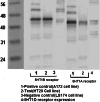Anti-mitogenic and apoptotic effects of 5-HT1B receptor antagonist on HT29 colorectal cancer cell line
- PMID: 20306273
- PMCID: PMC11827785
- DOI: 10.1007/s00432-010-0801-3
Anti-mitogenic and apoptotic effects of 5-HT1B receptor antagonist on HT29 colorectal cancer cell line
Abstract
Purpose: There is lack of evidence about impact of 5-HT receptors on colorectal cancers. The current study was designed to investigate the role of serotonin and its receptors in colorectal cancer cell line and tissues.
Methods: In cell cultures, we investigated the effects of 5-HT and 5-HT(1A,1B,1D) agonists and antagonists on proliferation of HT29 cells. We also tested apoptosis for the receptor antagonists. The expression of 5-HT1(A,B,D) receptor subtypes was examined by immunohistochemistry and western blotting.
Results: Our data indicated that 5-HT(1B) receptor was fully expressed in HT29 cell line and tumor tissues. MTT proliferation assay also revealed that serotonin and CP93129 dihydrochloride, a selective 5-HT(1B) receptor agonist, stimulated growth of HT29 cells. Further, SB224289 hydrochloride (that is a selective 5-HT(1B) receptor antagonist) had anti-proliferative and apoptotic effects on HT29 cells.
Conclusions: The findings of this study provide evidence for the potential role of 5-HT(1B) receptor in colorectal cancer. Further investigation is required to explore the effect of receptor antagonists on the prevention, prognosis and treatment of patients with colorectal cancer.
Figures





References
-
- Banes AK, Shaw SM, Tawfik A, Patel BP, Ogbi S, Fulton D, Marrero MB (2005) Activation of the JAK/STAT pathway in vascular smooth muscle by serotonin. Am J Physiol Cell Physiol 288:C805–C812 - PubMed
-
- Bradford MM (1976) A rapid and sensitive method for the quantitation of microgram quantities of protein utilizing the principle of protein–dye binding. Anal Biochem 72:248–254 - PubMed
-
- Cattaneo MG, Codignola A, Vicentini LM, Clementi F, Sher E (1993) Nicotine stimulates a serotonergic autocrine loop in human small-cell lung carcinoma. Cancer Res 53:5566–5568 - PubMed
-
- Cattaneo MG, Fesce R, Vicentini LM (1995) Mitogenic effect of serotonin in human small cell lung carcinoma cells via both 5-HT1A and 5-HT1D receptors. Eur J Pharmacol 291:209–211 - PubMed
-
- Dizeyi N, Bjartell A, Nilsson E, Hansson J, Gadaleanu V, Cross N, Abrahamsson PA (2004) Expression of serotonin receptors and role of serotonin in human prostate cancer tissue and cell lines. Prostate 59:328–336 - PubMed
MeSH terms
Substances
LinkOut - more resources
Full Text Sources
Medical

